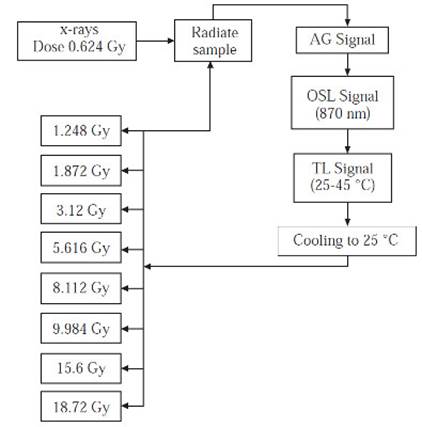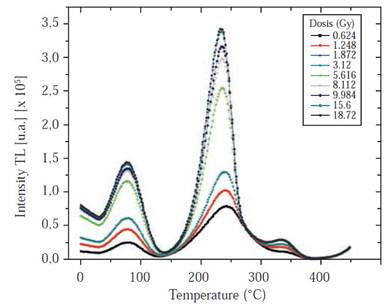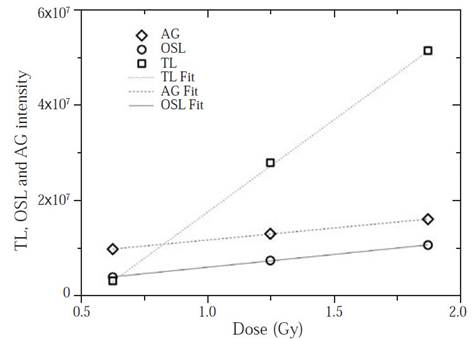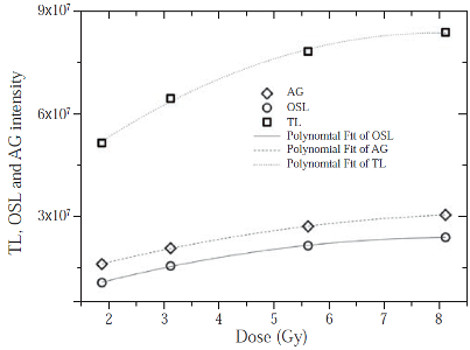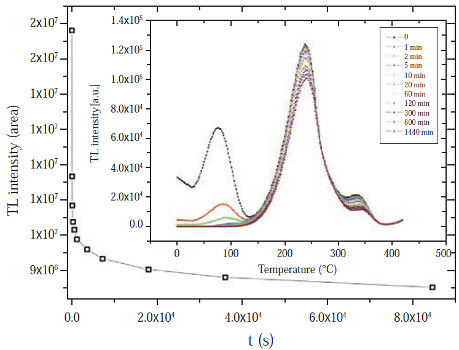Introduction
Currently, a good number of new techniques for the treatment of cancer, such as intensity-modulated radiation therapy, radiotherapy, helical, radiosurgery, radiotherapy, stereotactic, RapidArc and other, giving rise to deposit a high radiation dose in small fields Taylor, et al ., 2011. This type of treatment requires an in vivo dosimetry in real time (IV/TR). Currently, among the available technologies for dosimetry IV/TR, we can mention the ionization chamber diodes and detectors diamond, but the cameras are not used for dosimetry in-vivo due to its fragility, its large size and the need for electrical connections with high voltage. Diodes are used frequently for dosimetry IV/TR, but its answer presents fluctuations with temperature and accumulated dose. In addition, as its response is not equivalent to the soft tissue is necessary restricts them to increase the size of the device, so that its use in certain types of dosimetry, where you have rather small fields is not desirable Spasic, et al ., 2011; Morin, et al ., 2013.
A large number of materials with features luminescent have been studied recently Santiago, et al ., 2011; Molina, et al ., 2012; Guarneros, et al ., 2013; Marcazzo, et al ., 2015, with new techniques. Most of these materials tend to exhibit a sub-or over-response compared with the absorbed dose deposited in tissue, because these materials are not tissue-equivalent (Te) (Zeff ≈ 7.4). This aspect, entails that such composite materials behave in front of the radiation of a variety of ways to interact with the treated tissue, making it difficult for direct application in radiation therapy, a procedure widely used today for the treatment of cancer, if not the most common, and of special interest in the application of these devices. Recently, the synthetic diamond grown by the technique of high-pressure and high-temperature (HPHT) has been proposed as a detector of ionizing radiation Low, et al ., 2011; Meléndrez, et al ., 2006; Chernov, et al ., 2013; Gil et al ., 2014;Gil et al ., 2015. The importance of this material lies in its physical and chemical properties, as it has a Zeff=6 (atomic number-cash) equivalent to the human tissue, this is a relevant feature in a dosimeter for radiation therapy. In addition, this material is not toxic and it is hard to radiation, provides a high spatial resolution and presents a dependency with the dose rate. By these features, it is considered as a dosimeter with great perspective, the reason for which is studied in this work.
The dosimetric properties and characteristics of the brightness curve of the HPHT diamond are studied by the techniques of thermoluminescence (TL) and optically stimulated luminescence (OSL). The TL that exhibits the diamond was reported initially by the chemist Sir Robert Boyle in 1663, the closer a diamond is to the body and to observe the emission of light with their own eyes in the dark Chen & Kirsh, 1981. The brightness curve of the TL was studied with models of energy bands for the luminescence in solid materials, with which it is observed the efficiency and the activation energies of traps present in the material due to impurities in its crystal lattice, generated by the rupture in the periodicity of the crystal structure and makes it possible for electrons to possess energies which are forbidden in the perfect crystal Furetta, 2013; Mckeever, 1985; Oberhofer & Scharmann, 1993. On the other hand, the OSL is done in this work to observe the advantages of using optical stimulation in comparison with the thermal stimulation. The main advantage of OSL over TL is that measurements can be performed in situ and in vivo and in real time Yukihara & Shephen, 2011.
In this work the TL and OSL curves obtained in the Riso TL / OSL model DA-20 are studied, with the previous exposure of the HPHT type lb synthetic diamond to ionizing radiation with a “soft” X-ray tube with photons of 35 KeV at a dose rate of 0.624 Gy · s-1. The results obtained in this work have a very high chance to be applied in dosimetry in situ, in vivo and in real time, applying the technique of OSL, for their potential applications in medical diagnostics with ionizing radiation such as radiotherapy Meléndrez, et al ., 2006; Bos, 2007.
Materials and methods
The synthetic HPHT type lb (Sumicrystal, UP-3510) was purchased from ProDiamond, Germany. This diamond is a single crystal with dimensions of 3.5·3.5·1 mm3, which is performed by a heat treatment of 800 °C for one hour in an atmosphere of Nitrogen. The synthesis technique of HPHT diamond is based on the growth of films from graphite, which are obtained by applying a hydrostatic pressure of hundreds of kbar at a temperature of the order of 1700 °C on graphite substrate controlling the time (these parameters will define The thickness of the film). The Diamond type lb contains N atoms substitucionales isolated, with concentrations of about 40-400 ppm of N, where the 80% is in dispersed form and 20% in the form of aggregates of the same. In natural diamond, the concentration of N atoms scattered can be around 5·1010 cm-3, whereas the synthetic diamond is of the order of 1018 cm-3.
The curves of emission of the afterglow (AG), TL and OSL, were obtained on a computer Riso TL/OSL model DA-20 with a source of radiation of soft-X-ray with maximum power of 1 mA, 50 kV and 50 W. The voltage can be varied from 4-50 kV. When operating at maximum power, delivers a dose rate of 2 Gy·s-1 and when operated at its minimum power (0.25 mA, 10 kV) is supplied to a dose rate of 10 mGy·s-1Bøtter-Jensen, 2008.
With the previous exposure of synthetic HPHT type lb diamond to ionizing radiation using the “soft” X-ray tube, the irradiations were performed from an absorbed dose of 0.624 Gy to an absorbed dose of 18.72 Gy. First, it records the signal AG which is obtained at an exposure time of 300s. The signal TL is recorded from room temperature up to 450 ºC. The next step is to get the signal OSL using a filter BG-39 from the stimulation of diode laser infrared (870 nm) in a time of 60 s. In the TL curves, measurements of the activation energies of the maximum temperature peaks, the thermoluminescent fading or fading and the reproducibility of the HPHT type lb diamond were also performed.
The irradiations were performed in sequences of 0.624 to 18.72 Gy. Once the first irradiation was completed of the sample it is read TL from room temperature to 450 °C at a heating rate of 5 °C·s-1. Then the sample is subjected to cooling with a flow of nitrogen until they reach again the room temperature. Subsequently are available the sample to move to a different dose and is carried out the same procedure of reading to the dose prescribed.
To observe characteristics in the material due to charge carriers that can recombine at room temperature, it was performed after the irradiation, the measurement of the emission of light, called AFTERGLOW (AG), this emission of light is obtained by the photomultiplier tube at room temperature for 5 minutes). Again, a reading is taken TL in order to observe the recombination that occurred at room temperature, and to detect the light emission immediately after the irradiation. Then, it is performed the cooling for 1 minute and again irradiates the sample at the same dose to get the measure of the signal AG and subsequently obtain the signal of the OSL with the LED’s of the infrared. The signal is observed in the photomultiplier tube for 1 minute and performs the reading TL to get the fading of TL in the two methods mentioned, as described in Figure 1.
Results and discussion
In TL, exposure of the HPHT diamond to a source of radiation at room temperature (T0) is required followed by a caloric stimulus at a temperature T> T0 , to obtain the brightness curve (Emission intensity as a function of temperature) that Is shown in Figure 2.
The curve exhibits three broad peaks of the TL located at T≈77°C and T≈337°C, each one of them can be the result of the superposition of at least two peaks of TL, and the intensity for each peak is related to the number of charge carriers trapped and the number of defects that owns the material. It is also observed that with the increase of the applied dose, at doses > 9.984 Gy, reached a maximum in intensity of the peaks TL, which may be associated to the saturation of the sample.
For the analysis of each one of the peaks of TL of Figure 2, it was performed the analysis using these different techniques (TL, OSL, AG). For the luminescence emitted directly after the radiation, called a AG, it is found that the sample presents centers of recombination at room temperature that are related with the first peak of TL is located at T≈77°C.
To perform the experiments of OSL, it is observed T≈239°C, is recombined by using the photostimulation with diode laser infrared (870 nm). The OSL manages to recombine all carriers of charge, but fails to recombine charge carriers to the third peak of the TL located at T≈337°C, it was concluded then, that the peak of TL to T and T≈77 ºC are associated, to a great extent to the signal from the AG and the peak width of the TL located at T≈239°C, is the one that contributes mainly in the emission of the OSL, leaving only the peak TL high temperature T≈337°C, after the process of 300 s of the AG and 60 s of the OSL, as shown in Figure 3.
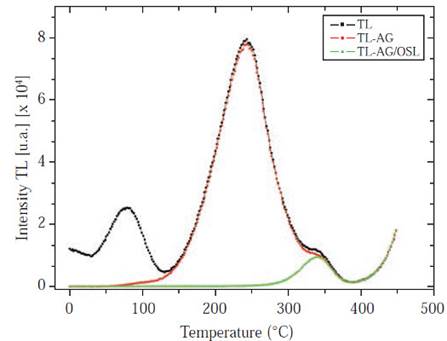
Figure 3 Comparison of the techniques TL immediately after irradiation and subsequently to the AG and TL, at a dose of 0.624 Gy.
A comparison of the three techniques (TL, OSL and AG) used in this work are also shown in Figure 3 and indicates the type of technique that must be used for each type of TL. The signal TL (black curve) corresponds to the irradiation with an absorbed dose of 0.624 Gy, subsequently observes the signal TL_AG (red curve) after you take the reading needle, where it can be observed the band between 30-60°C is evicted, or faded by the recombination of charge carriers at T0 for 300 s. third signal TL-AG/OSL (green curve) post to the AG and OSL, it can be seen that with the techniques of AG and OSL is achieved evict or to recombine most of the traps electrons close to the conduction band with the holes in the band of valence. Of these features it is inferred that these two techniques will allow the dosimetry, in-situ and invivo as reference in Yukihara & Shephen, 2011.
The McKeever method is widely used to determine with greater precision the number of traps present in the material dosimetry, the position of its peak in the brightness curve TL, as the energy of activation (E) and frequency factor (s). For the analysis of the brightness curve is used this method Mckeever, 1985. Figure 4A shows the graph of maximum Temperature (Tmax) in function of the end Temperature (T stop). In this Figure 4A, it is observing three peaks of the TL that are to be analyzed and located to temperatures of 103, 243 and 340°C, respectively, and correspond to a first order kinetics, that is to say, that the electrons released by stimulus heat transfer from the trap to the conduction band, and these subsequently recombine immediately with a hole by emitting a photon. Therefore, the re-entrapment of the charge carriers is negligible during the heating process of the sample of diamond for these three peaks. In Figure 4B, the curve TL can be associated to four peaks with different energies of activation and frequency factor whose values are reported in Table 1. In addition, it was observed that in the región between 250-290°C appears another peak of TL which may be related to defects in the sample.
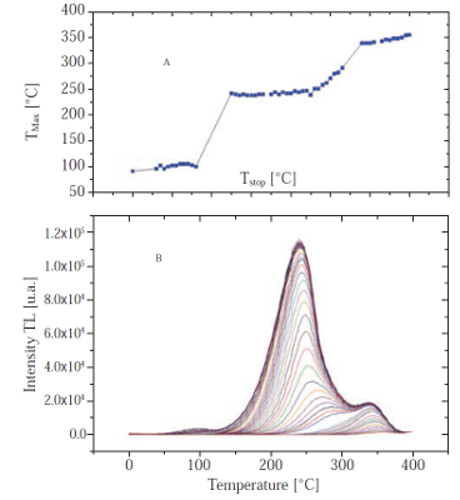
Figure 4 Analysis of the TL brightness curve by the Mckeever method after irradiation with X-rays at a dose of 1.872 Gy.
Table 1 Experimental determination of the activation energy factors and frequency factor of each trap for the HPHT diamond subjected to X-rays.
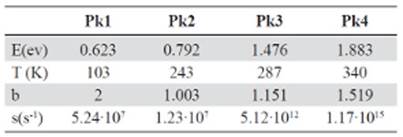
After analyzing and exposing the TL properties of the HPHT type lb diamond when subjected to X-rays, the dosimetric properties of the diamond were studied. For this, their response to the dose for the AG, OSL and TL techniques was analyzed. Each of the curves was studied between the different ranges of absorbed dose to establish the ranges in which it can be considered linear, supralineal or infralineal if it exists.
Figure 5 shows the dose range for which the diamond dosimeter can be considered linear. For this case, the values correspond respectively to a dose of up to ≈ 2 Gy and the values of the correlation factors are: AG = 0.99959, OSL = 0.99984 and TL = 0.99906.
Figure 6 shows the range of dose to which the dosimeter of diamond can be considered supralineal. In this case it is observed that can be considered supralineal up to ≈9 Gy. The values of the correlation factors correspond to: AG=0.99825, OSL=0.99273 and TL=0.99968.
From the above results and observing Figure 7, it can be concluded that the sample of HPHT diamond type lb presents a dose range for which the answer is linear, another range for which the response is supralineal and presents a saturation level a absorbed dose greater than 9 Gy.
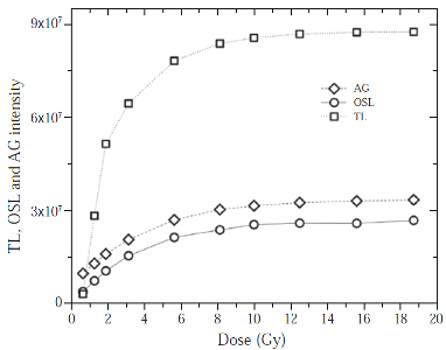
Figure 7 AG, TL and OSL dosimetry of the HPHT type Ib diamond as a function of the exposed dose of 0.624-18.72 Gy.
It was studied the fainting or fading of the signal TL postradiation in a 24-hour period, which is shown in Figure 8. During this time period, it was determined that in the first hour of the fading, the signal presents a loss of intensity of 60%. In the graphic inserted, it is noticed that this fall is associated to the peaks of ambient temperature and the peak located at 77°C, after an hour the fading of the signal is only 1%.
Finally, the sample of diamond was subjected to ten continuous cycles of exposure to radiation and the electrical signals AG, OSL and TL at a dose of 1.87 Gy. This process is performed in order to ensure the reproducibility in the signal with a percentage error of 5%.
Conclusion
In dosimetry of clinical dosimeters used must comply with important features for the estimation of the absorbed dose, one of them is the accuracy, which is related to the uncertainty of random associated to the measure and refers to the statistical method applied to a number of measures. The detector of Diamond is considered to be a detector of high precision and accuracy, this is contrasted with the reproducibility of the sample that presents a behavior in the signal characterized by a TL of (0.35%), a NEEDLE (4.25%) and a OSL (0.33%). These parameters obtained for the Diamond, it allowed to infer that this material in the future can be used as a dosimeter in clinical high accuracy.
The phenomenon of TL may be observed in many materials, however, only a few meet the requirements to be used in dosimetry clinic, with this work we show that for radiation beams of low energy, it is also an excellent material dosimetry.
It is observed that the sample presents a signal AG due to the peak of the TL located at room temperature and at 77°C, which recombines at room temperature and decays in 300 s. These features are ideal in dosimetry.
The TL is composed of at least 3 peaks widths of TL located around 77, 239 and 337°C, according to experiments obtained by the method of McKeever.
Studies of fading, after 1 hour have stability in the signal of TL, being the peak of 92°C responsible for this decay.
It was determined that the HPHT diamond type lb sample has values in a dose range where a linear response, supralineal and a saturation level at absorbed doses higher than 9 Gy appear.













